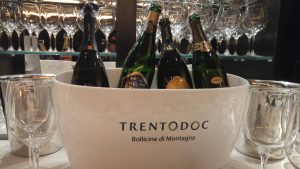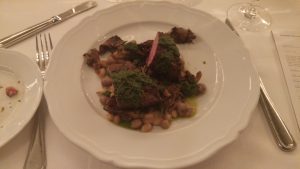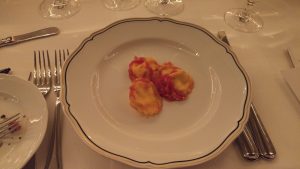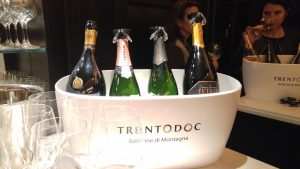
Sparkling wine is not about celebration so much as its presence creates a celebratory mood, potentially making any day a special one. There is something about the effervescence – the stream of tiny bubbles rising to the top of a crystal clear glass- that gives sparkling wine a distinctive and joyful spirit.
And why not celebrate the everyday? After all this is how the Italians in Trentino choose to live life.

Set high against the backdrop of the Dolomite Mountains, Trentino has been producing fine sparkling wines in the methode champenoise or Metodo Classico tradition for about a century. Trentino comprises 10,000 hectares of wine making territory and 10 percent of wine grapes grown in this region are used to make sparkling wines. This translates to roughly 8 million bottles of sparkling wine a year.
Guilio Ferrari, a Trento area winemaker who studied at the prestigious Instituto Agrario di San Michele all Adige, paved the way for fine sparkling wine production in Trento at the beginning of the last century when he decided to produce Metodo Classico wines after discovering that the climate and terrain in his native Trento were similar to those in Champagne, France.
Chardonnay, Pinot Nero (Pinot Noir), Pinot Bianco (Pinot Blanc) and Pinot Meunier-grapes used to make Trentodoc-are planted at altitudes between 200 and 800 meters using the pergola training system. The high and varying altitudes, coupled with a climate consisting of warm days and cool nights, along with D.O.C. regulated methods of winemaking come together to create wines that are fresh, crisp and complex.
Trento was the first wine producing region in Italy to receive sparkling wine D.O.C. status and bottles produced since 1993 reflects these quality standards. Grapes are hand selected and harvested before they are pressed and maceration takes place on the lees. The wine then undergoes secondary fermentation in the bottle (15 months for a Brut, 2 years for a Millesimato and 3 years for a Riserva), resulting in a build up of carbon dioxide (CO2). This process gives sparkling wine its effervescence.
The bottles are then placed tip down at an angle on pupitres or wooden trestles or racks and rotated regularly so that the dead yeast used in primary fermentation, as well as other sediment can collect at the tip of the bottle, be frozen and discarded. A blend of sugar and wine is then added to each bottle in its place. This mixture gives the wine its unique flavor and complexity.
The Instituto Trento Doc currently represents 49 producers in the region and their aim is to bring the distinctive flavor and versatility of this finely crafted sparkling wine onto the international wine scene. The Instituto Trento Doc showcased a diverse collection of sparkling wines from the region’s leading vineyards at Italian culinary powerhouse Il Posto in The Meatpacking District of New York City. The pairing of meticulously crafted sparkling Trentodoc varietals with flawlessly prepared Italian cuisine from this Bastianich family institution made an otherwise ordinary afternoon a cause for celebration.




The multi course menu, ranging from seasonal squash and root vegetable salads and handmade pastas to beef tartare and roasted lamb, revealed the adaptability of Trentodoc to a wide variety of cuisines. The broad flavor profile that characterize Trentodoc sparkling whites and roses make them not only wonderful apertifs but also good complements to an Italian- of course-but also an international array of cuisines.

Some highlights from the collection include an Altemasi Brut Rose consisting of 40 percent Chardonnay and 60 percent Pinot Nero that is fermented in stainless steel before undergoing 15 months of secondary fermentation in bottle. It was soft, supple and full of ripe strawberry, raspberry and subtly nutty notes. Another noteworthy cuvee from Altemasi vineyards was the Trentodoc Altemasi Riserva Graal, 2008, Brut Riserva comprised of 70 percent Chardonnay and 30 percent Pinot Noir. The base wine is fermented in stainless steel while a portion of it is also fermented for 8 months in oak barriques before it is aged in bottle for just under 6 years. The result is an elegant wine with a fine and persistent mousse, good structure, balanced acidity and fresh tropical fruit notes.
A Trentodoc Borgo dei Posseri Tananai, Brut, 2011 consisting of equal parts Chardonnay and Pinot Nero that is fermented in stainless steel and then aged in bottle for 3 years was delicate and fresh, with round notes of sweet strawberries and raspberries.
A Trentodoc Giulio Ferrari Riserva del Fondatore, Extra Brut, 2005 comprised of 100 percent Chardonnay and aged in bottle for a decade presented with a fine and persistent mousse. This low dosage cuvee was fresh, clean, balanced and full of complex citrus fruit notes followed by a refreshing finish.
A Trentodoc Brut +4 Rose Riserva Letrari, 2008 made up of 65 percent Chardonnay and 35 percent Pinot Nero and fermented in stainless steel tanks before undergoing secondary fermentation in bottle for 5 years was elegant and balanced with fresh acidity, ripe citrus fruit and lush strawberry notes.
A Trentodoc Madame Curtis Brut Riserva, 2007 consisting of 70 percent stainless steel fermented Pinot Nero, 25 percent oak barrique fermented (for 8 months) Chardonnay and 5 percent Pinot Meunier and aged in bottle for about 9 years was full of ripe orchard fruit and toasty notes.

Three offerings from Trentodoc Revi vineyards were particularly impressive. A Trentodoc Revi Paladino, Extra Brut Riserva, 2010 comprised entirely of Chardonnay and fermented in bottle for 4 years after primary fermentation in stainless steel was crisp with balanced acidity and green apple, citrus and apricot notes.
A Trentodoc Revi Brut Millesimato, 2013 made up of 75 percent Chardonnay and 25 percent Pinot Nero and fermented in stainless steel tanks before undergoing secondary fermentation in bottle for 36 months was full of effervescence, and fresh citrus and subtly creamy notes.
A Trentodoc Revi Cavaliere Nero, Extra Brut Rose Riserva, 2009 made up of 100 percent Pinot Nero that is fermented in stainless steel before undergoing 6 years of bottle aging was characterized by soft and supple strawberry and raspberry notes.

A Trentodoc Rotari Flavio, Brut Riserva, 2007 comprised entirely of Chardonnay (35 percent of which undergoes primary fermentation in oak for 6 to 8 months) that is aged in bottle for 5 years was elegant and marked by rich lemon, grapefruit and orchard fruit as well as vanilla cream notes.
A Trentodoc Maso Martis, Extra Brut Rose Riserva Bio, 2013 consisting of 100 percent Pinot Nero that undergoes secondary fermentation for 3 and a half years after primary fermentation in stainless steel tanks was full of lively citrus and orchard fruit as well as lush berry and soft nutty notes.

The broad flavor profile of Trentodoc coupled with the consistent quality production methods that goes into crafting them virtually guarantee its place at the table as an aperitif that will transition seamlessly into the choice to pair with lunch, brunch or dinner no matter what the occasion.

Be First to Comment